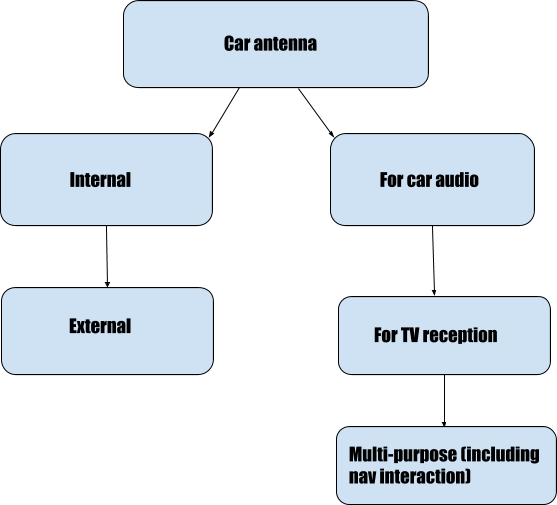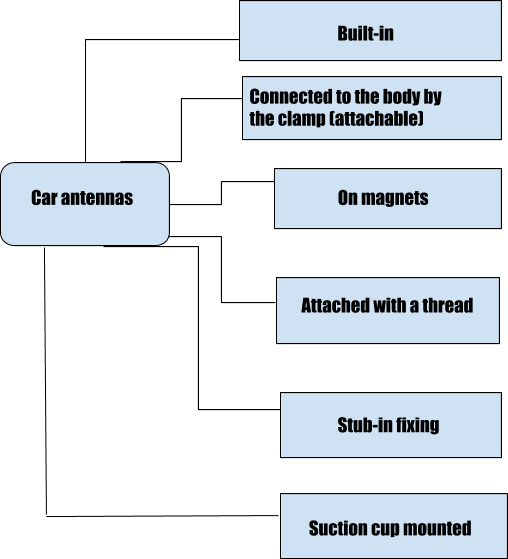Car antennas
If you stay in your car for too long, sooner or later you start needing some background music. It stimulates and relieves the tension and stress. Aside from music, you may listen to news channels, find out what’s the weather forecast and even watch TV in HD quality. One way or another, you require an antenna to listen to the music behind the wheel. New car models are fitted with a built-in autoplay system which consists of a player and receiver. The latter also requires antenna.
Let’s take a closer look at antenna types, whether you need to buy an expensive device or may be good with a simple device.
Classification and features of car antennas

Antenna is a part of oscillating circuit required to convert electromagnetic waves into electric signal which is then amplified by the input circuit of the receiver. Depending on the purpose, antennas may be plain, for listening to the radio from the car audio. There are also specific antennas which help to receive a TV signal as well as digital one. And finally, there are antennas that combine the functions of two aforementioned and also interact with the nav, transceiver. These antennas are called “the multi-purpose” and are the highest of all in quality of signal reception.
An expensive multi-purpose device, for sure, will be quite handy, however, is there any reason for paying over the odds if you have no TV in your car, and are not going to buy it in the nearest future?
Therefore, internal and external antennas are differentiated according to its availability in the car. Everything aside from the latter, is associated with the external antennas while the rest with the internal. External antennas are passive devices. The best way is to install them on the highest point of the car body. Thus, the outdoor environment will significantly affect such devices, and this is one of the negative points in application of external car antennas.
In-vehicle (or internal) antennas are mostly active, though the high power may result in signal distortions. Then you may switch from active to passive state. Internal antennas are usually more expensive than external.
Each antenna is installed differently:

Magnet fixing allows to do without ventholing the body parts and minimizes the risk of paint damage. The disadvantage of these antennas is that you have to remove a device at the unguarded parking lots to avoid theft. Another crucial disadvantage is an insufficient length of a pickup dipole.
Built-in type may imply antenna integration into dielectric glasses. These antennas make for very thin electric yarns connected to the glass by sealing-in. You may also use overprinting of metal grid on the glass surface as well as place the threads around the perimeter of glasses. Thus, your antenna may be mounted on the back, rear windows as well as windscreen.
Attachable antennas belong to the whip class and are attached to the car body with the particular brackets and thread connections. To install this type of antenna, use a water gutter or rear bumper while the design itself does not provide for any kind of amplifier. Since these elements of modern cars are made of plastic, be extremely careful. Perhaps, an attachable passive car antenna won’t suit you for this particular reason. Whip antennas require a cable connection through the interior.
If we talk about stub-in fixing, a hole in the metal body of the car may provoke the spread of rust. Stormy wind and high speed may result in a broken antenna. If it is telescopic, the sections gradually get loose and may get rusty as well. The contacts between the sections may destroy resulting in signal weakening. Thus, telescopic antennas require regular graphite greasing.
Antennas may also be asymmetrical and dipole by design. The first are mounted perpendicular to the radiowave distribution plane. That’s why they have an active component represented by:
- a telescopic design of several elements withdrawn manually or with a help of the electric drive;
- a pin which may have a convoluted spiral at the bottom.
Dipole antennas have two symmetrical pins which are mounted in a horizontal plane. Thus, receiving equipment of this type is mounted primarily inside the car.
In-vehicle antennas require electricity, however, one can hardly steal it without opening the cabin doors. While the external antennas may be damaged by some hooligans, the internal ones are not affected by the latter.
Tips on how to choose a cable for the car antenna
Pay attention to the features of the cable. First of all, there might be no cable available at all. Thus, you will have to obtain it elsewhere. Secondly, the cable may be too short, and you will have to elongate it (which definitely worsen the receiving signal quality. Then, an antenna cable must have a large sectional area. After all, a cable must be shielded. Keep in mind that a high quality of the cable provides an excellent signal.

Now you know what to consider before purchasing and installing a car antenna. However, do not distract your mind from car safety issues. First of all, you must have a paper allowing you to drive across the world confidently. Don’t waste the chance to get your International Driving License right here on our website.






